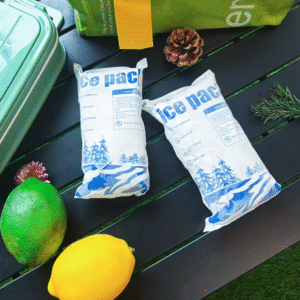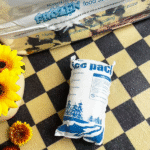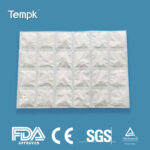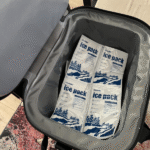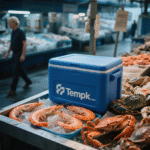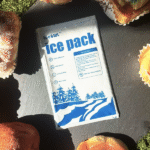Paquet de 48 Feuilles de pack de glace sèche: Comment les dimensionner?
Mis à jour: Octobre 2025. Si vous expédiez des marchandises sensibles à la température, un paquet de 48 feuilles de glace carbonique vous aide à emprunter les voies 24 à 72 heures sans trop dépenser. Ce guide montre comment tailler, condition préalable, et emballez les feuilles de manière à maintenir une température de 2 à 8 °C ou des bandes gelées stables, réduire le poids, et réussir les audits. Vous obtiendrez des calculs rapides, modèles d'emballage éprouvés, et 2025 les meilleures pratiques que vous pouvez appliquer aujourd'hui.
-
Choisissez quand un paquet de 48 feuilles de glace carbonique bat les packs de gel pour la logistique de la chaîne du froid
-
Calculez la quantité de feuilles pour des itinéraires de 24 à 72 heures avec des règles de dimensionnement simples
-
Utilisez des modèles d’emballage qui évitent les points chauds et les coins écrasés
-
Valider le respect des 2025 profils de test sans ingénierie excessive
Comment fonctionne un paquet de 48 Les feuilles de glace carbonique maintiennent les expéditions à une température comprise entre 2 et 8°C stables?
Une feuille de polymère hydraté gèle rapidement, répartit le froid uniformément, et peut maintenir une bande de 2 à 8 °C jusqu'à 48 heures avec la bonne isolation et la bonne précharge. Cela fait un paquet de 48 feuilles de glace carbonique idéal pour les échantillons pharmaceutiques, fruit de mer, et des produits frais qui ne supportent pas les bords chauds ou les pointes du couvercle. Comparé aux packs de gel standards, vous obtenez un empilage plus plat, poids plus léger, et moins de condensation lors du dégel.
Pack_of_48_Dry_Ice_Pack_Sheets_…
Pourquoi cela fonctionne pour vous: les nombreuses petites cellules de la feuille agissent comme une « courtepointe » de glace. Ils touchent plus de surface que les briques, donc la chaleur a un chemin plus long à parcourir. Préconditionner à la température dont vous avez besoin (0°C pour réfrigéré, −20°C pour surgelé), puis entourez la charge utile. Dans des itinéraires réels, un paquet de 48 feuilles de glace carbonique vous permet de mélanger des feuilles entières et des bandes pour combler les espaces et protéger les bords, réduire la détérioration et les réclamations. Vous simplifierez également la formation avec des modèles reproductibles.
Pack_of_48_Dry_Ice_Pack_Sheets_…
Quels modèles d'emballage conviennent à un paquet de 48 meilleures feuilles de glace sèche?
Commencez avec des motifs qui enveloppent les bords et le couvercle, parce que les points chauds commencent dans les coins et sur le panneau supérieur. Pour les petits expéditeurs, le wrap burrito est rapide et fiable. Pour 12 à 24 L, utilisez le motif couvercle et sol et ajoutez des bandes sur les longs murs. Les charges utiles de grande taille bénéficient d'une bande à 360° pour arrêter les points chauds verticaux près des volets. Ces modèles reproductibles aident les nouvelles équipes à obtenir des résultats cohérents le jour même 1.
paquet-de-48-blocs-de-glace-carbonique-feuille-g…
| Modèles courants en pack de 48 | Mieux pour | Nombre de feuilles typique | Ce que cela signifie pour vous |
|---|---|---|---|
| Enveloppement de burritos | Petites caisses ≤10 L | 2–4 | Mise en kit rapide; forte protection des bords |
| Couvercle & sol + murs | 12–Expéditeurs 24 L | 4–6 | Équilibre les dégradés haut/bas |
| 360° bande | Charges utiles élevées | 3–5 | Arrête les points chauds verticaux près des volets |
Conseils pratiques et gains rapides
-
Voies réfrigérées (2–8 ° C): Condition préalable un paquet de 48 feuilles de glace carbonique à ~0°C; pré-refroidir la charge utile et l'expéditeur.
-
Voies gelées (≤−15°C): Préconditionner à −20 °C et ajouter une isolation rigide sur le couvercle et la base..
-
Entraînement: Photographiez le colis final pour chaque voie pour créer une SOP d'une page.
Cas réel: Un exportateur de produits de la mer expédiant sous 24 à 36 heures a réduit la détérioration d'environ 30 % après avoir opté pour un paquet de 48 feuilles de glace carbonique et adoption du motif couvercle et sol avec des bandes murales. Le kit plus léger a réduit les coûts de transport aérien et stabilisé la température du couvercle..
Pack_of_48_Dry_Ice_Pack_Sheets_…
Combien de feuilles dans un paquet de 48 feuilles de glace sèche dont vous avez besoin?
Utiliser trois entrées : heures d'itinéraire, Valeur U de l'expéditeur, et bande cible - pour estimer le gain de chaleur, puis divisez par la capacité de refroidissement effective de la feuille. En pratique, commencer par 4 feuilles pour un expéditeur de 12 à 18 L à 2 à 8 °C pendant 24 heures, puis ajoutez 1 à 2 feuilles pour les voies chaudes ou un mauvais contrôle des voies. Pour les surgelés, ajouter 25 à 50 % de plus, en fonction de l'isolation et de la hauteur de la cheminée.
paquet-de-48-blocs-de-glace-carbonique-feuille-g…
Facilitez la tâche de votre équipe: décider de la voie (glacé, congelé, profond), inclure un tampon de risque égal à une analyse manquée ou à un tri retardé, définir le préconditionnement (0°C, −10°C, ou −20°C), et choisissez une enveloppe qui protège les bords. Avec un paquet de 48 feuilles de glace carbonique, vous pouvez superposer des feuilles entières et des bandes découpées pour obtenir des dégradés sans changer de SKU.
paquet-de-48-blocs-de-glace-carbonique-feuille-g…
Sont un paquet de 48 Les feuilles de glace carbonique sont plus sûres et plus conformes que la glace carbonique en vrac?
Pour la plupart des équipes, oui, moins de brûlures de manipulation, un étiquetage plus simple, et des emballages plus propres. Les feuilles sont de qualité alimentaire, non toxique, et réutilisable lorsque les joints restent intacts. Hydratez-vous toujours uniformément, congeler à plat pendant au moins 24 heures, porter des gants, et évitez les joints hermétiques avec des réfrigérants de type sublimation. Si vous effectuez des audits par rapport aux méthodes thermiques ISTA/ASTM ou aux attentes de l'OMS en matière de PIB, photographiez les emballages et enregistrez les temps de préconditionnement pour réussir avec moins de retouches.
2025 évolutions et tendances concernant les réfrigérants en plaques de la chaîne du froid
Règle de durabilité et de précision 2025. Les opérateurs standardisent un paquet de 48 feuilles de glace carbonique pour simplifier les chemins de sélection, tout en mélangeant les feuilles PCM pour un contrôle plus strict de 2 à 8°C et des prises de congélation plus longues. Les polymères biodégradables réduisent les déchets; des enregistreurs à faible coût vérifient les températures des couvercles; et les validations font de plus en plus référence aux profils de stress de livraison des colis pour refléter la manipulation réelle. Ces changements réduisent le poids, améliorer les taux de réussite, et un coût total inférieur.
Quoi de neuf en un coup d'œil
-
Matériaux en feuilles biodégradables: Moins de complexité d’élimination, plus de cycles de répétition.
-
Suivi de température intelligente: Analyse plus rapide des causes profondes des excursions.
-
Hybrides feuille-plus-brique: Des trajets plus longs sans changer de SKU.
Perspicacité du marché: Les équipes consolident les SKU dans un kit de 48 unités, se recycler autour de trois modèles standards, et introduction progressive de feuilles PCM de 2 à 8 °C pour les itinéraires à forte valeur ajoutée. Attendez-vous à une adoption plus large de modèles de validation standardisés et de SOP basées sur des photos pour raccourcir l’intégration et réduire les réclamations..
paquet-de-48-blocs-de-glace-carbonique-feuille-g…
Questions fréquemment posées
Q1: Combien de temps un paquet de 48 Les feuilles de glace carbonique maintiennent la température?
Généralement jusqu'à 48 heures avec une isolation et un préconditionnement adéquats; ajoutez des feuilles ou du PCM pour les voies plus chaudes ou les itinéraires plus longs.
Pack_of_48_Dry_Ice_Pack_Sheets_…
Q2: Puis-je réutiliser un paquet de 48 feuilles de glace carbonique?
Oui. Recongeler après décongélation, mais retirez toute feuille perforée, fuites de couture, ou agglomération rigide.
paquet-de-48-blocs-de-glace-carbonique-feuille-g…
Q3: Combien de feuilles pour 24 heures entre 2 et 8 °C dans un récipient de 12 à 18 L?
Commencer par 4 feuilles; ajoutez 1 à 2 si vous prévoyez des pics de chaleur ou des pertes d'ouverture de porte.
paquet-de-48-blocs-de-glace-carbonique-feuille-g…
Q4: Les feuilles sont-elles sans danger pour le contact alimentaire?
Ils sont fabriqués à partir de matériaux non toxiques, matériaux de qualité alimentaire adaptés au contact direct lorsqu'ils sont utilisés selon les instructions.
Pack_of_48_Dry_Ice_Pack_Sheets_…
Résumé et recommandations
Principaux à retenir: UN paquet de 48 feuilles de glace carbonique répartit le froid uniformément, emballe à plat, et maintient des bandes de 2 à 8 °C ou gelées pour des itinéraires typiques de 24 à 48 heures lorsqu'elles sont préconditionnées et emballées correctement.. Utiliser des modèles standards, paquets de documents, et la taille avec une règle empirique simple pour réduire les réclamations et les coûts. Pour les longs trajets, mélanger le PCM et ajouter une isolation rigide.
Étapes suivantes: Choisissez vos deux voies les plus courantes et créez des SOP d'une page avec des photos. Validez d'abord par rapport à votre itinéraire le plus populaire. Déployer une checklist de formation, puis ajoutez un enregistreur léger pour les températures du couvercle. Parler à tempk pour régler la capacité des feuilles, isolation, et des modèles d'emballage pour vos voies exactes.
À propos du tempk
Nous concevons des kits de tôles chaîne du froid et des packs PCM pour l'alimentaire, biotechnologie, et logistique spécialisée. Notre objectif: performances validées, mise en kit simple, et des matériaux responsables. Un paquet de 48 feuilles de glace carbonique vous donne des packouts répétables, fret plus léger, et moins de gaspillage, soutenu par des modèles pratiques et un support de formation.
CTA: Prêt à optimiser votre itinéraire? Contacter le tempk pour un plan de conditionnement et de validation spécifique à une voie.






